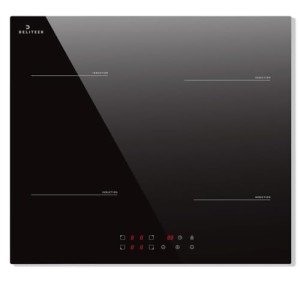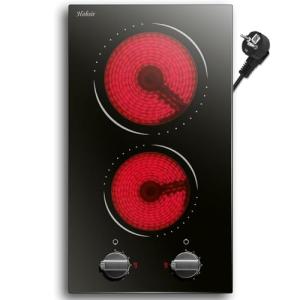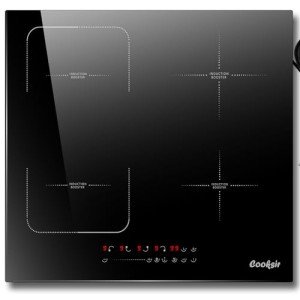Built-in integrated hobs are a game-changer for modern kitchens. They seamlessly fit into your countertop for a sleek, polished look while delivering powerful cooking performance. Whether you're a passionate home cook or just need something reliable, these hobs are designed to make your cooking experience easy and enjoyable.
Built In Integrated Hobs
Discover seamless cooking solutions that enhance your kitchen's style and functionality
Product List



Cooksir 4-Zone Induction Hob
Cooksir
Product Review Score
4.7 out of 5 stars
12 reviews£169.98 £139.00
In recent years, the modern kitchen has evolved beyond a functional space to become a stylish, efficient, and technology-driven hub of the home. One of the key components in this transformation is the built-in integrated hob, which blends seamlessly with countertops and cabinetry to deliver both performance and elegance. Designed to maximize space, improve cooking efficiency, and elevate aesthetics, integrated hobs are increasingly becoming a staple in contemporary kitchens.
This blog explores the features, benefits, varieties, and considerations of built-in integrated hobs, while also answering some frequently asked questions for homeowners looking to upgrade their cooking spaces.
What Are Built-In Integrated Hobs?
A built-in hob (sometimes referred to as a cooktop or integrated hob) is a cooking appliance installed flush with the kitchen countertop. Unlike traditional freestanding stoves, which combine burners and ovens in one unit, an integrated hob provides only the burner or heating surface. This allows greater flexibility in kitchen design, as ovens can be installed separately—often built into cabinets or at convenient heights.
Integrated hobs are available in different finishes, burner configurations, and fuel types, making them adaptable to various kitchen layouts and user preferences.
Key Advantages of Built-In Integrated Hobs
-
Space Optimization:
By seamlessly embedding into the countertop, built-in hobs free up space and reduce clutter in the kitchen. -
Aesthetic Appeal:
A sleek, flush design creates a streamlined look that aligns with modern interior design trends. -
Customizable Layouts:
Users can select burner arrangements, positioning, and size according to personal cooking needs. -
Ease of Cleaning:
The flat, integrated surface makes wiping spills and grease much more convenient compared to freestanding stoves. -
Safety Features:
Many models come with flame failure devices, auto-ignition, child locks, and residual heat indicators. -
Durability and Quality:
Built with tempered glass or stainless steel finishes, integrated hobs can withstand high temperatures while maintaining a polished appearance.
Types of Built-In Hobs
| Type of Hob | Description | Best For |
|---|---|---|
| Gas Hobs | Traditional flame burners with manual or auto-ignition. Widely used due to direct flame control. | Households that prefer instant flame adjustments and wok-style cooking. |
| Induction Hobs | Use magnetic fields to heat cookware directly, offering faster and energy-efficient cooking. | Modern households, health-conscious users, and energy savers. |
| Ceramic Hobs | Feature a smooth glass surface with electric elements beneath. Stylish and easy to clean. | Users looking for simplicity and aesthetics. |
| Hybrid Hobs | Combine gas and induction burners in one unit for versatility. | Families that want a balance of traditional and modern cooking. |
Features to Consider Before Buying
When shopping for a built-in hob, homeowners should carefully evaluate essential features:
- Size and Number of Burners: Available in 2, 3, 4, or 5-burner configurations to accommodate different family sizes.
- Control Knobs and Touch Panels: Traditional knobs are common, but touch controls are increasingly popular for a sleek design.
- Auto Ignition: Eliminates the need for lighters or matches.
- Safety Mechanisms: Flame failure protection, residual heat indicators, and timers improve overall safety.
- Material of Surface: Tempered glass offers an elegant finish, while stainless steel provides durability.
- Extraction Compatibility: Integrated hobs can sometimes be paired with downdraft extractors for better ventilation.
Pros and Cons at a Glance
| Pros | Cons |
|---|---|
| Sleek, modern aesthetic | Higher initial cost compared to freestanding stoves |
| Space-saving design | Professional installation often required |
| Variety of models and configurations | Less portable than standalone stoves |
| Easy to clean flat surface | Repairs may be costlier depending on brand and part availability |
| Advanced safety features in newer models | Cutting countertop surface is needed |
Installation Considerations
Installing a built-in hob requires precise measurements and some planning. Here are a few points to remember:
-
Countertop Cut-Out:
The countertop must be cut to the exact dimensions of the hob. Incorrect sizing can lead to either gaps or improper fitting. -
Professional Installation:
Due to gas pipelines or electrical connections, professional assistance is strongly recommended to avoid leaks or hazards. -
Ventilation:
Adequate airflow and proper chimney or extractor systems ensure smoke and odors are efficiently removed. -
Placement:
The hob should ideally be positioned in the “work triangle” of the kitchen (between fridge, sink, and cooking area) for convenience.
Style and Design Options
- Tempered Glass Finish: Available in black, white, or frosted finishes for a modern look.
- Stainless Steel Finish: Durable and resistant to scratches, often preferred in professional kitchens.
- Edge-to-Edge Grids: Provide more space to move pans around.
- Slimline Hobs: Specially designed for compact kitchens and apartments.
Maintenance Tips for Longevity
- Clean after every cooking session using mild soap and soft cloths.
- Avoid abrasive scrubbers that could scratch glass or steel surfaces.
- Check burners and nozzles regularly for blockages in gas models.
- For induction hobs, ensure cookware is induction-compatible.
- Schedule professional servicing annually to maintain optimum functionality.
Common FAQs on Built-In Integrated Hobs
Q1. Are built-in hobs better than freestanding stoves?
A built-in hob offers a more elegant and space-efficient solution than freestanding stoves. However, it requires more investment initially and professional installation. The choice depends on the kitchen’s design and the homeowner’s lifestyle.
Q2. How long does a built-in hob last?
With proper maintenance, built-in hobs can last 7–10 years or more, depending on the brand and usage.
Q3. Can existing countertops be modified to install a hob?
Yes, but the countertop surface must be professionally cut to specific dimensions. Granite, quartz, or marble counter modifications are best done by experts.
Q4. Is an induction hob safe for children?
Induction hobs are considered safer because they heat only the cookware, not the surface itself. Many models also feature child locks.
Q5. Do built-in hobs consume more electricity?
Induction and ceramic hobs do need significant power, but they are highly energy efficient compared to older electric cookers. Gas hobs remain cost-effective depending on local fuel prices.
Q6. Can I move a built-in hob if I shift houses?
While possible, it can be inconvenient because the hob is fixed into the countertop. Freestanding stoves are more portable, whereas built-in hobs are considered semi-permanent fixtures.
Built-in integrated hobs have become a hallmark of contemporary kitchens, combining functionality, aesthetics, and advanced technology. Whether a household prefers the traditional flame of a gas hob, the efficiency of induction cooking, or the versatility of hybrid models, there are options to match every lifestyle and budget.
While the upfront investment and installation effort may be higher than freestanding stoves, the benefits—in terms of design, convenience, and performance—make integrated hobs a worthwhile addition to homes that value modern living. Ultimately, the right choice enhances not only the cooking experience but also the overall appeal of the kitchen space.